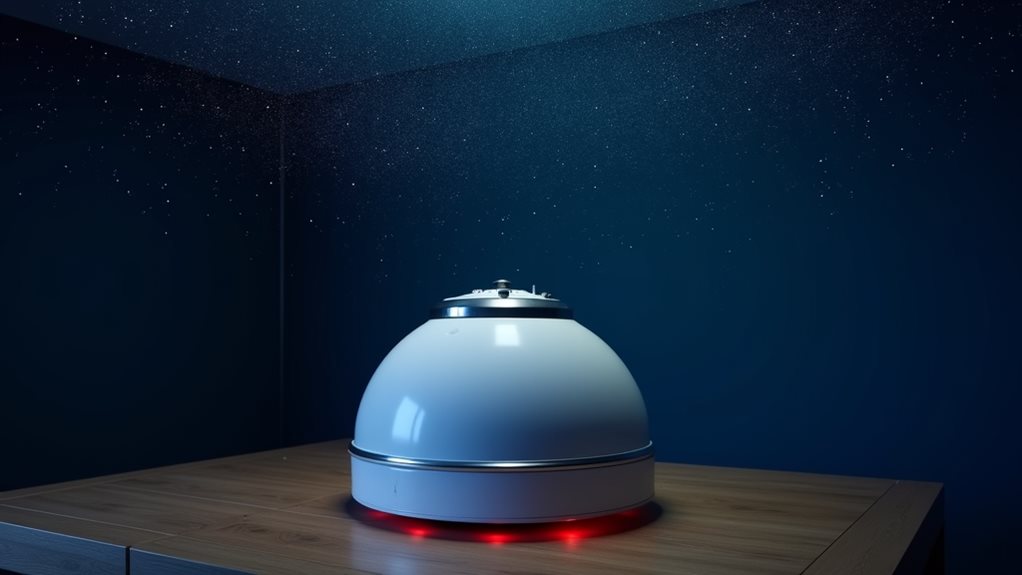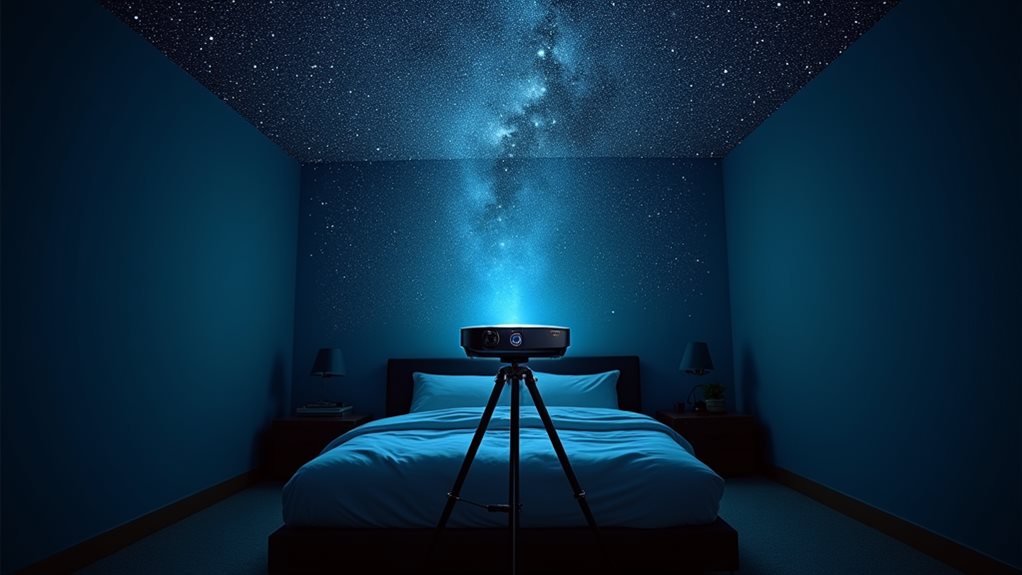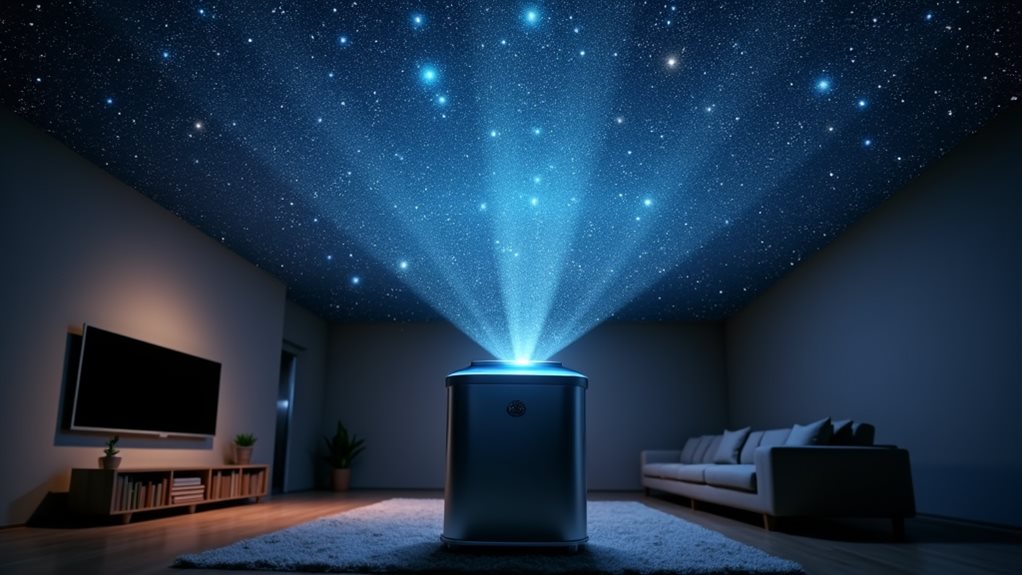Home planetariums bring the majesty of the cosmos into your living space through advanced LED projection technology that can display up to 60,000 stars. You’ll find models ranging from budget-friendly options to high-end systems like the Sega Toys Homestar Flux, featuring HD optics and NASA image slides. With proper setup in a dark room and ideal positioning, you’ll create an immersive stargazing experience that doubles as an educational tool. The universe of possibilities extends far beyond these basics.
Understanding Home Planetarium Technology and Features

While traditional stargazing requires clear skies and perfect weather conditions, home planetariums bring the wonders of the cosmos right into your living space through sophisticated projection technology.
You’ll find these devices equipped with powerful LED systems, ranging from 3 to 5 watts, capable of displaying up to 60,000 stars with remarkable clarity. Some models like the Brainstorm Toys Deep Space Planetarium even include NASA image slides for enhanced educational value. The technology draws inspiration from the Carl Zeiss projector developed in the 1920s. Many of these projectors also feature adjustable focus and rotation functionalities that further enhance the viewing experience.
Modern star projection systems incorporate high-definition optics and glass lenses that’ll transform your ceiling into a vibrant celestial display.
You’re not limited by fixed settings either – with adjustable focus capabilities, you can customize the projection distance from 120cm to 290cm, depending on your room’s layout.
Whether you’re looking to explore constellations, witness shooting stars, or simply create a relaxing atmosphere, these versatile devices offer you the freedom to experience the night sky on your terms.
Selecting the Perfect Home Planetarium Model
Selecting the right home planetarium model can feel like steering through a constellation of choices, but understanding key features will help you chart your course.
When conducting model comparisons, you’ll want to focus on projection quality, star count, and functionality that matches your stargazing aspirations. Higher-end models often deliver more detailed projections, enhancing the overall experience.
Through careful feature evaluations, you’ll discover options ranging from high-end models like the Sega Toys Homestar Flux, which projects over 60,000 stars, to budget-friendly alternatives like the Smithsonian Optics Room Planetarium. Flagship models like the DS1 feature chrome disc technology that resists fading and ensures long-lasting quality.
Consider your space’s dimensions and how you’ll use the device – whether for detailed astronomical study or creating a relaxing atmosphere. For optimal viewing results, ensure you can achieve complete darkness in your chosen room, as ambient light can significantly diminish the experience.
Don’t forget to factor in additional costs for accessories and check warranty terms. Understanding the importance of optional discs can enhance your enjoyment through varied projections that cater to different themes.
Reading reviews from fellow stargazers will provide valuable insights into real-world performance and reliability.
Setting Up Your Home Planetarium for Optimal Viewing

To achieve the full magic of your home planetarium, proper setup and positioning play essential roles in creating an immersive stargazing experience.
You’ll want to begin by finding the perfect spot, ideally where you can control ambient light and have enough space for comfortable viewing angles. Just as with real telescope viewing, maintaining steady air conditions will enhance the clarity of your projected celestial display. Additionally, ensure that you select a location that minimizes light leakage, as this will improve visibility for your projections.
When following setup tips, start by connecting your planetarium to power, then insert your chosen disc – whether it’s a sky, Aurora, or scenic option. The entire process should take two to three minutes to complete.
Position the projector at the ideal height, typically on a stable shelf, and take time to adjust the focus for crystal-clear celestial views.
Don’t forget to manage power cables safely to prevent tripping hazards.
For the most enchanting experience, you’ll want to experiment with different viewing angles and use the rotation feature to explore various celestial perspectives.
Educational Benefits and Learning Opportunities
Beyond serving as enchanting entertainment, home planetariums offer remarkable educational benefits that can transform your living space into an astronomical classroom.
Much like portable planetarium programs, these setups can accommodate learners of all ages while providing astronomy-themed lessons at home. They provide an engaging way to spark an interest in astronomy that can lead to lifelong exploration and discovery.
Similar to how astronaut navigation training was conducted in professional facilities, these immersive tools help develop spatial orientation skills.
You’ll discover how interactive learning takes shape as you explore celestial phenomena, from tracking moon phases to understanding planetary orbits, all from your personal viewing space. These immersive experiences help you grasp complex astronomical concepts that traditional textbooks can’t effectively convey.
Whether you’re homeschooling children or pursuing your own astronomical interests, you’ll find that a home planetarium supports various learning styles while making astronomy accessible and engaging.
It’s particularly effective when paired with formal education, reinforcing classroom concepts through hands-on exploration.
Market Analysis and Future Developments

While home planetariums have traditionally served educational and entertainment purposes, today’s market shows remarkable growth and technological advancement that’s reshaping the industry.
Market trends indicate you’ll soon experience immersive LED displays, real-time content generation, and integration with virtual reality platforms right in your living room. These advancements are paving the way for more realistic planetarium projectors, providing a more authentic stargazing experience.
Thanks to modern digital audio technology, planetarium experiences now offer superior sound quality and spatial audio capabilities that complement visual elements perfectly.
Future innovations are transforming how you’ll interact with celestial content, as emerging technologies make home planetariums more accessible and sophisticated. The introduction of accurate night sky representations will elevate both the educational and recreational value for users.
You’ll benefit from decreasing technology costs and improved visualization capabilities, while having the freedom to explore space in unprecedented ways.
The integration of big data from space exploration and satellite imaging means you’ll have access to the latest astronomical discoveries.
School groups make up a significant portion of traditional planetarium visitors, making home planetariums an attractive alternative for individual astronomy enthusiasts.
Whether you’re a casual stargazer or serious astronomer, these developments are making home planetariums more compelling than ever.
Frequently Asked Questions
Can Home Planetariums Accurately Display Seasonal Changes in Constellations?
You’ll find that modern home planetariums can accurately show constellation patterns and seasonal visibility changes, letting you explore the night sky’s transformations throughout the year right from your personal space.
How Often Should LED Light Sources Be Replaced in Home Planetariums?
You’ll need to replace your LED light source every 2-5 years, depending on your usage patterns. With typical LED longevity of 20,000-50,000 hours, you can extend replacement frequency by using lower brightness settings.
Are Home Planetariums Suitable for Professional Astronomical Research Purposes?
You won’t be able to conduct professional research with a home planetarium due to significant research limitations. Their basic features and projection quality don’t meet professional applications required for serious astronomical studies.
Can Multiple Home Planetariums Be Synchronized for Large-Scale Educational Presentations?
You can synchronize multiple planetariums using specialized educational technology and synchronization methods, giving you the freedom to create immersive learning experiences for large groups through coordinated presentations and interactive displays.
Do Home Planetariums Affect Sleep Patterns When Used in Bedrooms?
You’ll find that bright projections can disrupt sleep quality if you’re light-sensitive, but dimmer settings used briefly before bed might actually help you relax. Just avoid running them all night long.
Final Thoughts
You’ll find that bringing the cosmos into your home through a planetarium isn’t just about entertainment—it’s an investment in wonder and knowledge. Whether you’re an amateur astronomer, educator, or curious stargazer, today’s home planetarium technology offers unprecedented access to the mysteries above. By carefully considering your needs, space, and budget, you’ll discover the perfect system to transform your ceiling into a gateway to the universe.

